Home » MedECC reports » Special Report Interlinking climate change with the Water – Energy – Food – Ecosystems (WEFE) nexus in the Mediterranean Basin » Summary for Policymakers [EN]
Special Report Interlinking climate change with the Water - Energy - Food - Ecosystems (WEFE) nexus in the Mediterranean Basin
Summary for Policymakers [EN]
Table of contents
Notes
In the SPM, the references for material contained in the full Special Report are given in curly brackets {}.
In the SPM, the Sustainable Development Goals (SDG) Index is used. This assesses each country’s overall performance with regard to the 17 SDGs, giving equal weight to each goal. The score signifies a country’s position between the worst possible outcome (score of 0) and the target (score of 100). The 2023 edition of the SDG Index includes 97 global indicators. Two-thirds of the data come from official statistics (typically United Nations custodian agencies) with one third from non-traditional statistics (e.g. derived from large-scale collection of passive data or remote sensing, produced by research centres, universities, and non-governmental organisations). Published since 2015, the SDG Index and dashboard has been peer-reviewed and the global edition was statistically audited by the European Commission in 2019. More detailed information is available on the website www.sdgindex.org.
Each assessment finding is based on an evaluation of underlying evidence and agreement. A level of confidence is expressed using five qualifiers: very low, low, medium, high and very high, and typeset in italics, for example, "medium confidence". The following terms have been used to indicate the assessed likelihood of an outcome or result: virtually certain (99–100% probability); very likely (90–100%); likely (66–100%); about as likely as not (33–66%); unlikely (0–33%); very unlikely (0–10%); and exceptionally unlikely (0–1%). Additional terms (extremely likely (95–100%); more likely than not (>50–100%); and extremely unlikely (0–5%) are also used when appropriate. Assessed likelihood is typeset in italics, for example, "very likely".
In the SPM, the Special Report on Emissions Scenarios (SRES) defined in IPCC AR4 and Representative Concentration Pathways (RCP) defined in IPCC AR5 are cited. RCPs are greenhouse gas concentration trajectories (not emissions) used for the 5th phase of the Coupled Model Intercomparison Project (CMIP5) and labelled in line with a possible range of radiative forcing values in the year 2100: 2.6, 4.5, 6.0, and 8.5 W m-2 respectively. These correspond to one stringent mitigation scenario (RCP2.6), two intermediate scenarios (RCP4.5 and RCP6.0) and one scenario with very high GHG emissions (RCP8.5). SRES scenarios are organised into four socio-economic families (A1, A2, B1 and B2), translated in terms of greenhouse gas and aerosol emissions. SRES scenario B1 is similar to RCP4.5, scenarios B2 and A1B1 are similar to RCP6.0, and scenario A2 is similar to RCP8.5. In the report, low-emissions scenario refers to RCP2.6, intermediate emissions scenarios refer to SRES scenario B1, B2, A1B1 or RCP4.5 and RCP6.0, and high-emissions scenario refers to SRES scenario A2 or RCP8.5.
Executive Summary: Water-Food-Energy-Ecosystems (WEFE) nexus in the Mediterranean
The Mediterranean Basin, cradle of an ancient cultural heritage, culinary traditions, indigenous knowledge of agricultural practices and biodiversity, is often referred to as a “climate change hotspot”, as the regional projections of global climate change are exacerbated with higher rates than globally. It also has highly vulnerable specific critical resources (water, agriculture, etc.) and socio-economic elements (adaptive capacity, human population growth, etc.). Population and economic growth, agricultural intensification, urbanisation, high pollution levels in air, land, seawater, and freshwater, tourism and increasing resource demand and inequality, all increase the vulnerability of local communities, the impacts on human health and the level of insecurity for water, energy, food and ecosystems (WEFE). Resource overexploitation is contributing to their rapid depletion and consequent environmental degradation, putting the capacity of Mediterranean countries to reach the Sustainable Development Goals (SDGs) of the 2030 Agenda at risk. The unsustainability of WEFE elements is not only characterised by insecurity but also by large disparities across countries (North-South divide mainly) and across territories (rural and urban areas), and by the multiple interlinkages (nexus), including synergies and trade-offs, between the four WEFE nexus components.
Among the key challenges faced by Mediterranean countries are water scarcity issues and strong dependency on energy and food imports. Three main pathways for action are currently being implemented to promote synergies between water, energy, food and ecosystems: (1) implementation of innovative technological solutions often relying on renewable energy and enhanced efficiency; (2) ecosystem-based solutions, including agroecology and Nature-based Solutions (NbS) such as green infrastructure and wetlands restoration; and (3) social approaches to reduce or modify consumption patterns, such as promoting restrained consumption and sufficiency, and adoption of the Mediterranean diet.
However, despite these actions, the current situation is not satisfactory for these four components with regard to the expectations of the nexus approach, and shows a concept-to-implementation gap. This gap is due to (1) the lack of accessible and reliable data on key indicators and variables; (2) insufficient knowledge, understanding and awareness of nexus synergies and trade-offs; (3) insufficient incentives and investments; (4) higher costs of nexus approaches in the short term as compared to silo approaches; and (5) the lack of adequate governance, which include the lack of inter-sectoral and multi-level coordination.
Despite existing platforms for exchanging and consolidating know-how and experiences in the Mediterranean, actions and interventions need to be enhanced to build institutional capacities which include (1) a science-policy interface as one way of reinforcing coherence; (2) enhanced funding mechanisms; (3) intra-regional dialogue; (4) deliberative approaches; and (5) pilot nexus approaches through modelling and assessment for more coordinated WEFE actions in the Mediterranean.
A. Interconnected water, energy, food and ecosystem security challenges
A.1. Background for the assessment
A.1.1. All recent assessments of anthropogenic climate change for the Mediterranean Basin, including the IPCC AR6 and MedECC assessment reports, indicate ongoing warming, exceeding global average rates, of the atmosphere (+1.5°C above the pre-industrial level) and the sea (0.29°C–0.44°C per decade since the early 1980s), changes in rainfall distribution (10 to 30% drop on average) and continuous sea level rise (1.4±0.2 mm yr7 during the 20th century). The combination of observed and projected increases in climate hazards, coupled with high regional vulnerability and exposure, make the Mediterranean area a ‘climate change hotspot’ (high confidence) {1.2}. High temperatures cause direct damage to humans and ecosystems. Among the main risk factors identified in the Mediterranean are drought (meteorological, hydrological, agricultural, and socio-economic droughts), due to trends characterised by a widespread increase in evaporative demand resulting from temperature increase, and a decrease in precipitation, leading to an increase in the duration and intensity of meteorological and hydrological droughts {1.2}. Drier conditions and increasing water scarcity are significant threats to agriculture and ecosystems, and to a lesser extent energy, through hydropower and thermoelectric plants (medium confidence) {2.2.2}. At sea, the impacts of climate change include the increasing acidification of seawater likely reducing marine productivity, affecting species distribution and triggering local extinction, as well as the rise in mean sea level, which has already increased by 6 cm over the past 20 years (high confidence). It could reach between 40 cm for the lowest greenhouse gas emissions scenario and 100 cm for the highest emissions scenario by 2100, increasing the risk of coastal flooding (high confidence) {1.2}.
A.1.2. Greenhouse gas emissions in the Mediterranean Basin account for 6% of global emissions, equally distributed between northern and southern regions, corresponding to an equivalent proportion of the global population, with fossil energy accounting for 76% of the energy mix and significant variation between countries. The power production sector represents 30% of the total, while industry represents 14%, the building sector 16%, the transport sector 28%, and other sectors 12%, including industrial process emissions, indirect emissions (for nitrous oxide only), agriculture (agricultural soils, agricultural waste burning, enteric fermentation, manure management), and waste. Mediterranean countries have significant potential to mitigate climate change with high potential for renewable energy, particularly in the South and East. Adverse effects of climate change on thermo-electric production and hydropower, and to a lesser extent solar and wind energy production, should be accounted for to meet energy demand, expected to decrease in the north of the basin and increase in the Middle East and North African (MENA) countries {1.2}.
A.1.3. The Mediterranean Basin has a long history of adaptation to harsh environmental conditions, such as dry and hot climates, and often poor soils. This has resulted in landscapes and agricultural practices that have been developed over millennia of human presence in this region {1.2; 3.1}. These practices and associated knowledge have been substituted through industrialisation and lifestyle changes that have not been adapted to Mediterranean conditions, with impacts on WEFE components {2.1.1.2}.
A.2. Current status of the WEFE nexus in relation to the Sustainable Development Goals (SDGs)
Insecurity for all nexus components (water, energy, food, and ecosystems) is the rule rather than the exception in many countries of the Mediterranean Basin, and this has far-reaching implications in terms of sustainability. The region faces pressing challenges of water insecurity (e.g. water stress), energy insecurity (with heavy dependence on mostly imported fossil fuels), food insecurity (comprising the triple burden of nutrition) as well as ecosystem insecurity (e.g. fast rate of biodiversity loss, on land and in the ocean) (Figure SPM1). However, unsustainability in all WEFE components is not only characterised by insecurity, but also by the existence of large disparities between countries, as well as by the multiple interlinkages between the four nexus elements.
A.2.1. Mediterranean countries are facing numerous interrelated challenges in terms of access to and availability of water, energy, food and fertile land, as well as with regard to how these elements depend on and potentially impact ecosystems. Mediterranean countries face several challenges in their implementation of the 2030 Agenda for Sustainable Development and are not on track to achieve many Sustainable Development Goals (SDGs). This is particularly relevant for SDGs relating to WEFE components, such as food (SDG 2), water (SDG 6), energy (SDG 7), and ecosystems (SDGs 14 and 15). The Mediterranean region has a general SDG Index score of 73.5 but there are huge differences between the sub-regions; the SDG Index shows better performance in Western Europe and lower values in Eastern Europe and MENA countries. The SDG scores of Mediterranean countries in 2022 ranged from 81.1 in France (ranked 4th globally) to 59.3 in Syria (global rank: 126) {4.1}.
A.2.2. Water insecurity originates from water scarcity due to droughts, flood-induced risk to infrastructure, degradation of water quality, and unequal access {1.2; 2.1.1.3}. Water plays a critical role in maintaining healthy ecosystems, reducing global disease, empowering women, enhancing the welfare and productivity of populations, adapting to climate change, and fostering peace, acting as a vital connection between the climate system, human society and the environment. Achieving SDG 6 (clean water and sanitation) is therefore essential to attaining all other SDGs, which is of particular importance in the Mediterranean Basin {1.1}. From the perspective of SDG 6, there are significant disparities between countries and most of the countries have significant challenges to address {4.1}. Already, 180 million people suffer from water scarcity in the Mediterranean, but the quality of water is also decreasing with the increase in water salinity due to groundwater overexploitation and the presence of pollutants (e.g. nutrients and heavy metals) {1.2; 2.2; 2.3.1}. The key challenge for all MENA countries is water availability – due to frequent droughts leading to water scarcity and unsustainable use of limited water resources and overconsumption {4.1}. Challenges related to overexploitation of water resources and unsustainable water use leading to water shortages are due to a lack of sound water governance and in particular, of proper implementation of Integrated Water Resources Management (IWRM) {1.2}. Water shortage can lead to competition between sectors, including agriculture, industry, drinking water supply and tourism {1.2}. It can also lead to conflicts when combined with socio-political, economic, and environmental factors {2.3.1.3}.
A.2.3. Food insecurity in the Mediterranean is significant and it is characterised by the triple burden of malnutrition: undernutrition, overnutrition and hidden hunger. The worst cases are found in North Africa, where all countries face major challenges. Achieving SDG 2 (zero hunger) presents one of the most critical challenges of all WEFE components. Statistics on the prevalence of undernourishment are not accessible for countries such as Palestine and Syria. None of the Mediterranean countries achieved the targets by 2020 and for all of them, either significant or major challenges remain, with disparities between countries {4.1}. High dependency on food imports, particularly for MENA countries, makes the region highly vulnerable to external uncertainties and variability outside the Mediterranean region. A dietary shift away from the traditional Mediterranean diet among the population, particularly children and adolescents, is mainly accompanied by increased malnutrition trends in the form of overweight and obesity, as well as degradation of ecosystems and greenhouse gas emissions (high confidence) {2.3.1.3; 3.2.6; 4.1}.
A.2.4. The region faces challenges in securing its energy supply and matching demand. For most Mediterranean countries, achieving SDG 7 (affordable and clean energy) is still a challenge despite variable progress over time in some of them. Access to electricity in urban areas is universal in most Mediterranean countries (i.e. 100% of the urban population has access to electricity). Access to electricity is lower in rural areas {4.1}. The challenge for nearly all Mediterranean countries, except Algeria, Egypt, and Libya, is their strong energy dependence on imports. Energy insecurity in the region is also increased by the existence of political conflicts between countries {4.1}. The share of electricity produced from oil, gas and coal sources ranges from less than 10% in France to more than 90% in Algeria, Croatia, Cyprus, Egypt, Israel, Jordan, Lebanon, Libya, Malta, Syria, and Tunisia. In general, Mediterranean countries are still highly dependent on fossil fuels to produce electricity {3.2; 4.1}. Renewable energy consumption only accounted for 11% of total energy consumption in 2020, about nine percentage points lower than the European Union (EU) and three percentage points lower than the global level {1.2}. Reducing energy demand, including increased energy efficiency and energy sufficiency, is necessary to reduce environmental degradation. It is also advantageous for the region to explore alternatives for ensuring energy security, particularly in light of the limited presence of established policies to reduce energy demand. Mediterranean countries have significant potential to mitigate climate change through an accelerated energy transition, including renewable energies deployment that requires effective land and sea use planning to avoid conflicts with other uses {1.2; 2.2.4}.
A.2.5. Marine and terrestrial ecosystems are under acute pressure in the Mediterranean region. Biodiversity loss, deforestation, wildfires, land use changes, and pollution are widely reported trends that are severely undermining Mediterranean ecosystems {1.2; 4.1}. Both marine and terrestrial ecosystems face significant challenges in the Mediterranean, where most countries are not on track to achieve SDGs 14 (life below water) and 15 (life on land). Forest degradation is expanding, and some polluting sectors are undergoing rapid growth, such as coastal mass tourism and land and maritime transport {1.2; 4.1}. With regard to marine ecosystems, unsustainable fishing, warmer temperatures, acidification and water pollution, including underwater noise, all reduce marine productivity, affect species distribution and trigger local extinctions {1.2}. Twelve Mediterranean countries still face major challenges with SDG 14, while seven others face significant challenges. The situation improves slightly with terrestrial ecosystems (SDG 15), but still, ten Mediterranean countries face significant challenges, whereas three countries face major challenges to achieve this SDG {4.1}.
Figure SPM1 | Schematic of the WEFE concept and report outcome for the Mediterranean Basin.
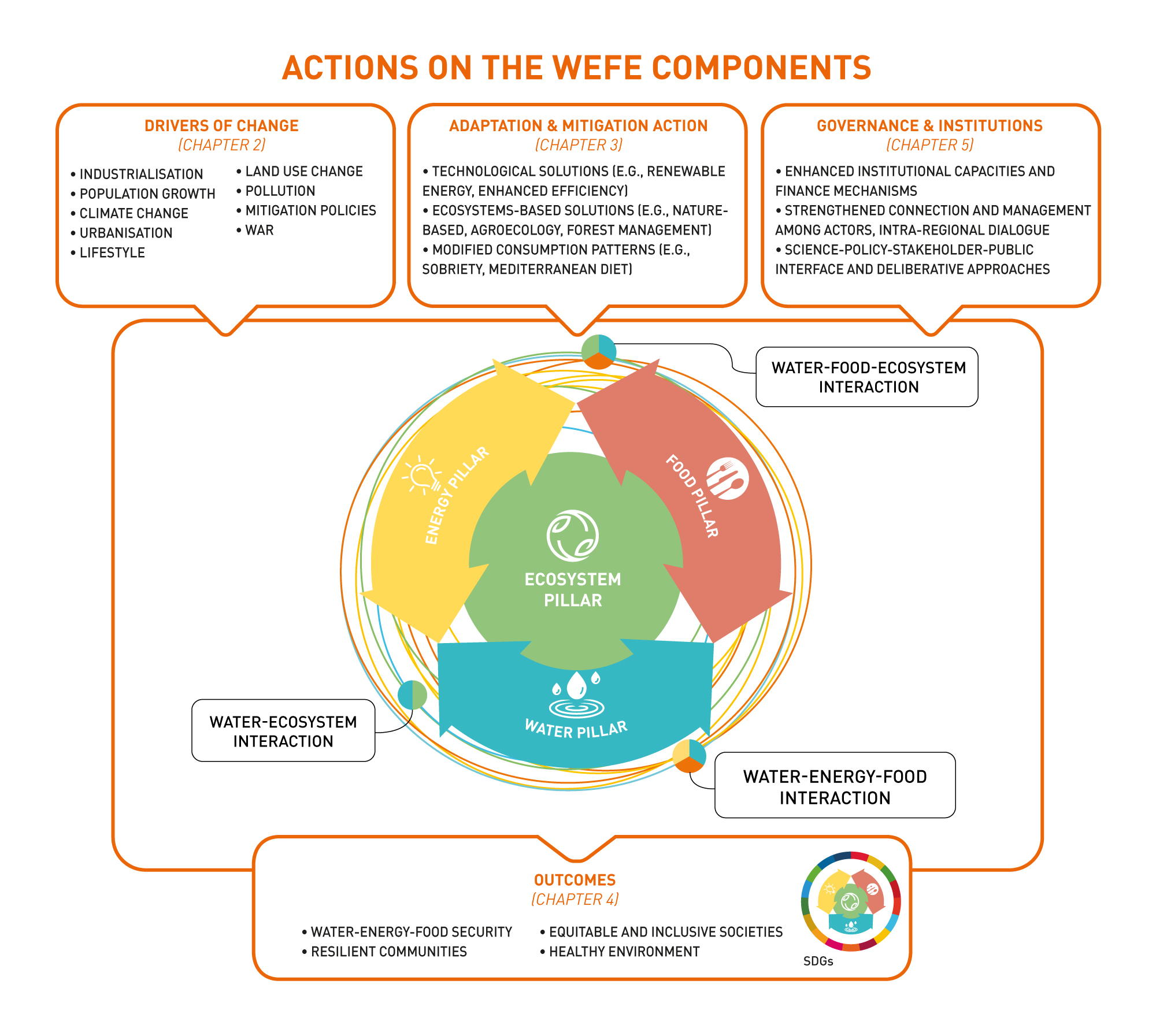
Figure SPM1 | Schematic of the WEFE concept and report outcome for the Mediterranean Basin. A variety of direct and indirect drivers of change impact the WEFE components. WEFE has a series of two, three and higher level interactions that need to be addressed through appropriate governance and institutions capable of developing adaptation and mitigation actions that promote synergies to achieve water, food, energy security and ecosystem health in compliance with the SDGs.
A.3. Impact of the drivers of change on the WEFE nexus
WEFE challenges are amplified by current and future direct and indirect drivers of change that are external to the WEFE nexus, particularly climate change, pollution, land use changes, population growth, lifestyle changes, urbanisation, migration, industrialisation, and conjunctural crises such as pandemics and conflicts.
A.3.1. Water security in the Mediterranean is affected by a combination of factors, including climate change, densely concentrated population growth, pollution, saltwater intrusion, land use practices, and unsustainable resource management, among others {1.2; 2.2.1}. Future mean precipitation projections for the Mediterranean region foresee reductions of approximately 4% per 1°C global warming (high confidence for global warming levels above 2°C with a marginal projected increase in winter at the northern boundary of the northern Mediterranean) {1.2; 2.2.1.1}. Under a 2°C warming scenario, the frequency and duration of meteorological droughts are projected to increase in the southern Mediterranean countries, and the frequency of agricultural droughts is projected to be 150 to 200% more likely (high confidence) {2.2.1.1}. Population growth, economic development and lifestyle changes have led to increased water demand, resulting in water shortages and depletion of water resources (high confidence). The increasing levels of urbanisation, industrialisation, and unsustainable agricultural practices have led to a heightened need for water, which has resulted in unsustainable rates of water consumption {3.1; 3.2}. Inefficient irrigation methods are responsible for the squandering of water resources and the aggravation of water scarcity in the area {3.2} (high confidence). Moreover, unsustainable resource management has resulted in pollution of water resources and groundwater depletion {2.2.1.3}. In addition, inadequate land and resource management practices are also a contributing factor to water insecurity. The water-infiltration and water-holding capacity of soils can be adversely affected by activities such as deforestation, soil erosion, and improper land use practices, which can increase the likelihood of flash floods and reduce water quality {2.2.1}.
A.3.2. Land and environmental degradation, pollution, land use changes, water scarcity, rural exodus and urbanisation, climate change, and dietary change lie behind the current levels of food insecurity in the Mediterranean {2.3.1}. There are large disparities between regions, with a significant gap between the northern, southern and eastern Mediterranean. Population growth and conflict in some countries increase food insecurity. Climate change presents a significant threat to agricultural productivity, especially in arid and semi-arid regions. Decrease in crop yields, caused by reduced water availability and heat stress, is likely to affect staple crops such as olives, grapes, fruits, cereals, and vegetables. Levels of projected changes vary depending on countries, scenarios and crops, ranging from –80% for sunflowers in Spain and +26% for olives across the entire Mediterranean Basin (medium confidence). Agricultural land can be lost due to coastal water, soil salinisation and desertification {2.3.2}. The livestock sector is expected to suffer the negative effects of heat stress, limited feed resources, and deteriorating health and productivity. Climate change also impacts fisheries and aquaculture, resulting in the regional eradication of significant aquatic taxa {2.3.1.1} and modification of species distribution {1.2}. Furthermore, industrialisation and urbanisation have significantly transformed the Mediterranean agricultural sector. This transformation has been exacerbated by various factors, including a shift towards modern lifestyles, increased food demand and increased international trade. The region is subject to significant impacts from changes in land use {2.3.1}. Food security concerns in the region are further aggravated by the compounding challenges arising from conflicts such as the Russo-Ukrainian War, and the region's significant reliance on food imports. The potential consequences of disturbances in the food and fertiliser industries, in conjunction with the impacts of climate change, can be significant in terms of both the availability and accessibility of food {2.3.1.3}.
A.3.3. The main drivers of change affecting energy production and demand are primarily not climate-related (population growth, lifestyle changes, industrialisation, and mitigation policy planning) {2.4.1}. Climate change through increased temperatures marginally affects solar energy production (less than 2% decrease for global warming levels up to 3°C) (low confidence) {1.2; 2.4.1.1}. Regarding wind energy, projected wind speed decline affects wind energy production (up to 8% decrease for global warming levels of up to 3°C) (low confidence) {1.2}. Hydropower and thermo-electric production, including nuclear, is expected to decline due to decreased streamflow and increased water temperature, leading to a 10 to 15% decrease in thermopower by 2050 in the highest emissions scenario (high confidence) {1.2; 2.4.1.1}. Nuclear power plants situated along the coast are exposed to the potential impact of rising sea levels and flooding caused by extreme weather events. Quantification of global warming impacts on future energy demand is still highly uncertain but non-climatic drivers (e.g. population growth, urbanisation and modernisation) suggest a decrease of 10 to 23%e by 2040 compared to 2015 in the northern Mediterranean and an increase of 55 to 118% in 2040 compared to 2015 in the MENA countries {1.2; 2.4.1.2; 2.4.1.3; 2.4.1.4}.
A.3.4. Climate change has major impacts on dryland ecosystems in the Mediterranean region, including vegetation productivity, biodiversity, and the stability and northward expansion of semi-arid regions. The coupled effect of warming and drought increasing aridity is related to the decrease in the provision of several terrestrial ecosystem services such as soil conservation, water storing capacity, timber, mushrooms and food production, tourism and recreation, biodiversity and carbon storage. Furthermore, climate change increases the vulnerability of ecosystems towards diverse forms of disturbances, such as wildfires, pests, and diseases, etc. {2.5.1.1}.
A.3.5. Conjunctural drivers of change, such as recent conflicts and pandemics have suddenly negatively impacted the WEFE nexus and its hierarchical constituents, as well as the SDG indicators {4.1}.
B. Cascading impact of drivers of change through the nexus components
WEFE challenges are amplified by current and future direct and indirect drivers of change that are external to the WEFE nexus, particularly climate change, pollution, land use changes, population growth, lifestyle changes, urbanisation, migration, industrialisation, and conjunctural crises such as pandemics and conflicts. The change in WEFE components due to climatic and non-climatic drivers can affect the relevance of adaptation and mitigation measures at various temporal and spatial scales. The complex web of interactions between WEFE components can first result in cascading effects through which changes in one element from drivers of change result in changes in the other WEFE components, in turn generating multiple loops and feedback paths. Sustaining healthy ecosystems needs to be at the heart of interventions, since degraded ecosystems cannot provide their associated ecosystem services, hampering water, food and energy security.
B.1. Cascading from the water pillar (Figure SPM2)
B.1.1. The generally negative change in the water component causes an almost direct negative change in all food access and availability indicators as the water and food pillars are significantly correlated (high confidence) {2.2.2; 2.3.1.1}. Water scarcity reduces agricultural yields, and the agricultural sector, which is a significant water consumer in the region, is facing mounting challenges in obtaining adequate water resources for irrigation purposes {2.2.2; 2.3.1}. Actions seeking to increase water availability for irrigation using groundwater can lead to sea water intrusion and salinisation, reducing water quality and availability and further degrading ecosystems. The energy required to pump this water may contribute to greenhouse gas emissions and reduce energy available for other purposes. Actions seeking to increase water availability for irrigation using treated wastewater contribute to reducing pollution and can provide fertilisers that increase food availability, but compete with other energy uses {2.2.2}.
B.1.2. The projected declines in streamflow and increases in water temperature may lead to a strong decline in hydropower and thermoelectric power usable capacity in the Mediterranean (–2.5 to –7.0% for hydropower and from –10 to –15% for thermoelectric power in 2050s) (high confidence). The potential CO2 emissions reduction from decreased use of nuclear (low-CO2 emissions) or fossil fuel (large-CO2 emissions) thermoelectric production depends on the technologies used {2.2.2; 2.4.1.1}.
B.1.3. Changes in the hydrological cycle and water quality due to pressure from climatic and non-climatic drivers significantly impact the structure and functioning of wetlands and riparian ecosystems, which are recognised as biodiversity hotspots in the Mediterranean (high confidence). These changes cause a loss of habitat for aquatic biota, rich and dynamic riparian plant communities, and waterbirds, and impact important migratory corridors and foraging hotspots. {2.2.2; 2.5.1.1}.
B.2. Cascading from the food pillar (Figure SPM2)
B.2.1. To address the impacts of the drivers of change on food security, actions aimed at increasing agricultural yield through business-as-usual responses linked to agricultural intensification and industrialisation can negatively impact ecosystem health through salinisation or changes in land use (high confidence) {2.3.2; 2.3.3}. Increased irrigation, as the main strategy for boosting crop productivity in the Mediterranean, can have a high cost in terms of water use and water pollution (e.g. nitrate leaching and salinization of over-exploited aquifers) (high confidence) {2.3.2.; 2.3.3; 3.2.2}. The contamination of water bodies by industrial and agricultural activities results in a decline in water quality, making it unfit for human consumption and detrimental to the well-being of ecosystems. Additionally, the projected increase in irrigation crop requirements under climate change scenarios can exacerbate existing competition for water resources between sectors (medium confidence) {2.3.2}. Industrialisation of agriculture leads to ecological deterioration, characterised by deforestation, amplified emissions of greenhouse gases, escalated energy consumption, and augmented water and fertiliser usage. The implementation of intensification techniques frequently results in agricultural land abandonment and a shift towards the cultivation of annual crops and monocultures, thereby affecting ecological sustainability and posing potential threats to biodiversity and agrobiodiversity. The decrease in agrobiodiversity poses an additional threat to the robustness of agricultural systems and traditional Mediterranean cuisine (high confidence) {2.3.1}.
B.2.2. Increased consumption of animal-based products due to population growth and lifestyle changes is responsible for an increase in greenhouse gas emissions and the disruption of local and regional nitrogen cycles, causing relevant impacts on ecosystem health (high confidence). Addressing this challenge by increasing unsustainable production and not targeting consumption behaviour leads to the same cascading effects as further agricultural industrialisation, with impacts on the water and ecosystems components {2.3.3}. The link with the energy component is the growing need for energy for food production, with further detrimental impacts if fossil fuels are the source of energy production, and increasing CO2 emissions with decreasing adherence to the Mediterranean diet {2.3.2; 2.3.3}.
B.3. Cascading from the energy pillar (Figure SPM2)
B.3.1. Promotion of renewable energy to address the impacts of the drivers of change on the energy component can lead to land competition. The land requirements necessary in the Mediterranean region to fulfil 100% of current primary energy use are lower than 10% for hydropower, solar photovoltaics and wind, while for biomass, spatial requirements already exceed 100%. The spatial requirements for nuclear or natural gas never exceed 0.7%. With energy demand in MENA countries expected to double by 2040 compared to 2015, the fraction of land dedicated to energy production could reach over 10% of total land, with risks in terms of land degradation and biodiversity loss, while it could also conflict with food production and negatively impact food availability (medium confidence) {2.4.2}. Spatial planning and reduction in demand could help avoid these potential trade-offs.
B.3.2. Increasing energy production involves more water use. In Europe, water withdrawals for energy production are on average similar to those for agricultural irrigation {2.4.2}. In the MENA region, the share dedicated to irrigation is much higher (80%). However, this should be put into perspective with the water scarcity in these countries. Only a small fraction is consumed (6% for EU countries with large disparities between countries), the remainder being returned to the hydrological system. However, the energy sector remains an important part of withdrawals, negatively affecting water availability and competing for water with food {2.4.2}. Impacts on ecosystems due to excessive water withdrawals are also considerable. The Mediterranean region’s dependence on power generation methods that require significant amounts of water, such as hydroelectric, thermal, and nuclear plants, therefore exposes it to the risk of reduced water availability and difficulties in managing water resources due to the effects of climate change.
B.3.3. Energy is a crucial input (upstream) in food processing and fertiliser production. If no changes are introduced to agricultural practices, the potential reduction in fertilisers will influence agricultural production by introducing lower yields into current monocropping agricultural systems. Consequently, a smaller quantity of farm products would be available to the food processing industry, leading to a reduction in market supply and a potential increase in prices {5.1.4}. Any increase in energy prices can also result in an increase in food prices, limiting access to food for the poorest populations.
B.4. Cascading from the ecosystem pillar (Figure SPM2)
B.4.1. The impact of climate change on ecosystem health can reduce the productivity of ecosystems and diversity at all levels, from intraspecific to landscape level. The degradation or depletion of ecosystems reduces the provisioning (water, food, biomass) and regulating (water quality, storm protection, carbon sequestration) ecosystem services provided by healthy ecosystems. In the case of water, climate and environmental changes combined with heightened concentrations of pollutants in aquatic environments could potentially result in a reduction in the quality of water, and a rise in sediment accumulation. Nevertheless, the effects are intricate and multifaceted, and not all ecosystems are affected equally. It is important to note that certain changes in climatic conditions may even lead to the enhancement of ecosystem services in specific instances {2.5.2}.
B.4.2. The reduction in biodiversity and degradation of ecosystems negatively affects the maintenance of soil structure and fertility, decomposition, remineralisation, and recycling processes, pollination, seed dispersal, and pest and disease control, which subsequently negatively impacts food availability {2.5.2}.
B.4.3. Changes in ecosystems, such as deforestation or alterations in water availability, may impact the accessibility and durability of energy resources, thereby causing potential impacts on the production and provision of renewable energy sources such as biomass and hydropower {2.5.2}.
Figure SPM2 | Impacts, interactions and cascading effects on the WEFE outcomes of drivers of change and solutions.
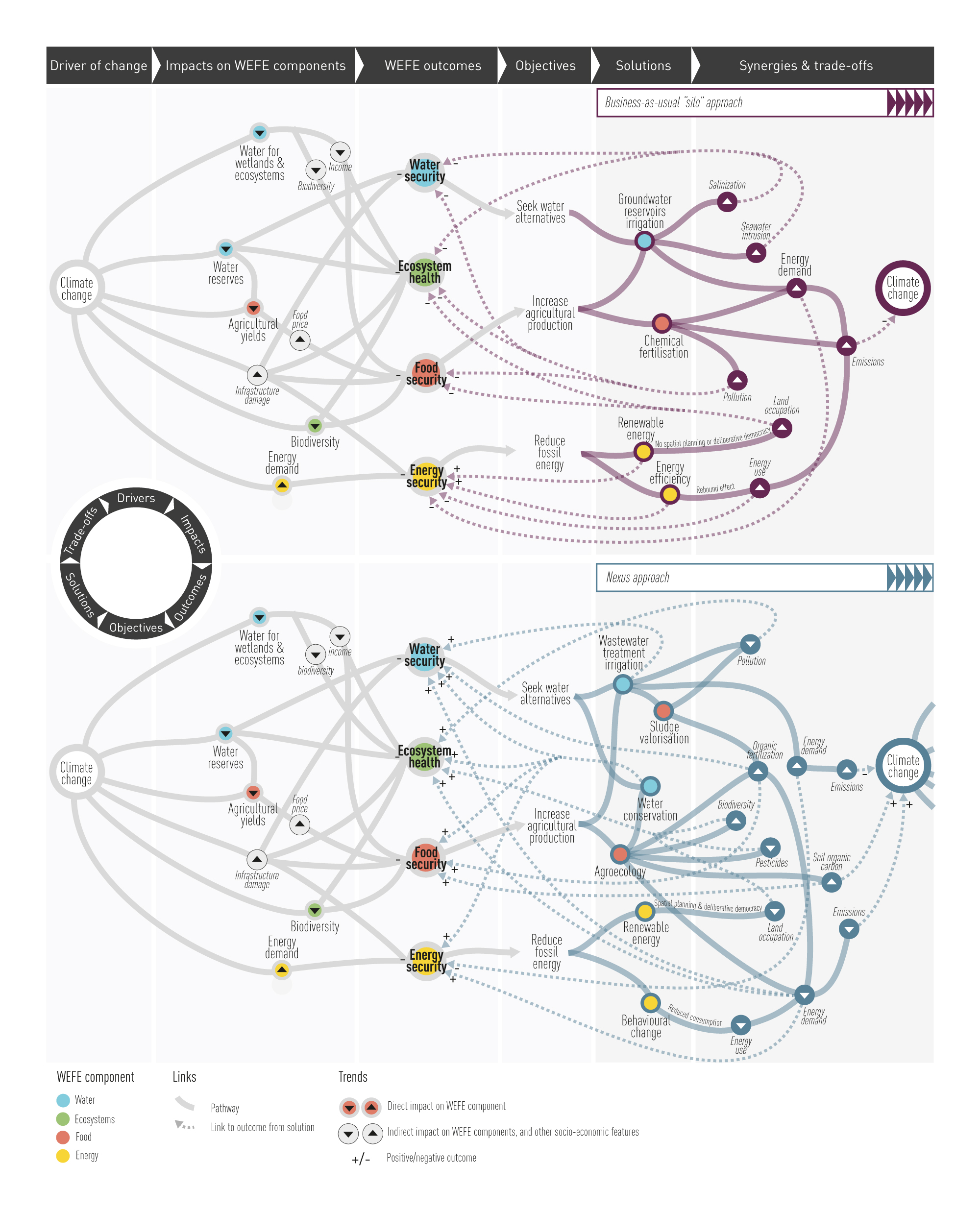
Figure SPM2 | Impacts, interactions and cascading effects on the WEFE outcomes of drivers of change and solutions. Climate change impacts the WEFE components. Policymakers need to find solutions to achieve water, food, energy security, and ecosystem health. Solutions developed following a silo-approach may reinforce the trade-offs, negatively impacting WEFE outcomes and increasing climate change. By integrating complexity, a nexus approach can significantly reduce impacts and promote positive WEFE outcomes.
B.5. Adaptation and mitigation solutions
Adaptation measures focusing on a single societal goal and one WEFE component can result in negative trade-offs, leading to maladaptation. In agricultural systems, this is partly due to adaptation pursuing a single goal, i.e. maximising short-term food production, which often means intensive agriculture, detrimental for soils and biodiversity. In the forestry sector, adaptation focusing on single societal goals, such as the spread of non-native tree species, can lead to higher fire risk (medium confidence). Integrated adaptation solutions are needed to address security issues, considering that mitigation consequences of the nexus approach can result from potential synergies and trade-offs derived from the interconnections between WEFE components.
B.5.1. A nexus approach to adaptation and mitigation actions promotes synergies between the WEFE components and minimises potential trade-offs. This is clear in the Mediterranean region as climate and environmental change negatively affects WEFE components both separately and through the cascading impacts of the drivers of change (high confidence). Silo approaches include poor and unsustainable irrigation practices leading to increased soil salinity and overall land degradation, or overexploitation of rangelands leading to soil erosion and land degradation (high confidence). Nexus approaches can include new irrigation techniques or returning to traditional ones, reuse of treated wastewater or desalinated water using renewable energy, agrivoltaics without land competition, or agroecological practices, such as agroforestry, intercropping and cover crops, which can reduce freshwater consumption, increase water conservation and reduce energy footprint while attempting to maximise local food production and protect ecosystems {3.2.1; 3.2.2}.
B.5.2. Adaptation and mitigation solutions are usually distinguished on a gradient of two main types: incremental and transformative (Figure SPM3). They include a variety of options, such as ecosystem-based approaches (including Nature-based Solutions, NbS), and technological and social innovation, including behavioural changes targeting consumption and lifestyle patterns, that can effectively address interrelated WEFE security issues and SDGs {3.2} (Figure SPM4). NbS include a set of actions inspired and supported by nature that simultaneously provide environmental, social and economic benefits, and help build resilience {3.2.2.1}. NbS strategies involve the implementation of blue and/or green infrastructure (e.g. green roofs and walls, urban grasslands and meadows, horticultural gardens, vegetated filter strips, swales, constructed and natural (or rewilded) wetlands and ponds). Early warning systems, climate services and risk management approaches have also shown broad applicability across various sectors in the Mediterranean and would benefit from incorporating an integrated nexus approach. Decision support tools, online platforms, and other products co-developed with users can provide information and services to support their decision-making {3.2.3.1}. Policies and actions that operate across the food system can have significant potential to adapt to climate change and reduce emissions, among other benefits (high confidence) {3.2.3.1}. These involve promoting sustainable ecosystem and forest management that includes changes in agricultural and livestock systems to increase carbon storage in soils (e.g. agroecological approaches such as agroforestry or well-managed extensive livestock systems) and simultaneously targeting behavioural change, including reducing food loss and waste or influencing dietary choices (e.g. reducing overall meat consumption). They can thereby enable more sustainable land use management, enhance food security, reduce water use, water contamination and soil degradation, and promote biodiversity conservation.
B.5.3. There are a large variety of implemented solutions at various spatial scales, with uneven distribution across the whole Mediterranean basin (Figure SPM4). Social options based on behavioural change show the highest positive effect on all four pillars of the nexus, with a robust amount of evidence. In general, green options, such as Nature-based Solutions (NbS) and agroecological management practices, have positive impacts on the four pillars and are the most transformative (Figure SPM3), although further evidence is needed to assess specific NbS {3.2.3}. More evidence is required to assess the effect of adaptation options related to governance and institutions, in particular on policies for water pricing and limiting and reducing water use {5.1.4}. Some first attempts have shown solely positive effects on the four pillars. Options related to water use and management are the most complex and controversial, because they can have negative impacts on other pillars, but this negative effect seems low and requires better analysis {3.2.3}.
B.5.4. Drivers of change are evolving at a fast pace with strong impacts WEFE components, potentially jeopardising the resilience of already implemented actions {2.2.1, 2.3.1; 2.4.1; 2.5.1}. A modelling-based nexus assessment based on different climate, socio-economic and demographic change scenarios using different disciplines helps understand the resilience level of sustainable development options and avoid maladaptation and unanticipated effects {1.3.2; 3.3.2}. However, nexus modelling requires access to long-term series of data and open platforms {3.3.2}. It is therefore advisable to consider changes in system variables when designing integrated policies.
B.5.5. Transformative adaptation relies more on social innovation and requires increasing human inputs and system re-organisation, but it can be the most appropriate response to climate change and other drivers of change, when the severity of the expected impacts is particularly high or when current incremental adaptation options are reaching their limits in terms of implementation and functionality {3.1}. Adaptation and mitigation solutions can range from those more related to ecological and consumption-reducing behaviours to those more related to scientific and technological innovation {3.2}. Science and technology are part of the solution but require a broad understanding and societal engagement to achieve transformation through behavioural change. The varying levels of engagement of, and trust in, different stakeholders, including civil society, in the Mediterranean region, hampers the development of a nexus approach that demands a high level of cooperation and mutual trust {3.3}. Implementation of new technologies requires increasing participation and considering social concerns to avoid maladaptation.
B.5.6. Adoption and implementation of adaptation and mitigation measures can be undermined by various financial, scientific, geographic and institutional challenges. The implementation of solutions that take into account the nexus can be more cost-effective and cost-efficient than other solutions, however this requires considerable funds in the initial stages. Financing such approaches can be further hindered since WEFE programmes have many important socially oriented components that are typically of limited commercial value and potential {3.4.1}. Many northern Mediterranean countries are more likely and more financially ready to support such initiatives, whereas southern and eastern Mediterranean countries could require international support and commitment in the form of financial or scientific support to increase the adoption of the new approaches that will lead, in the long term, to the sustainability of the entire Mediterranean {3.4.4}. Indeed, technology implementation in southern countries still lacks adequate financing and appropriate policies {3.4.4}.
Figure SPM3 | Different gradients of possible adaptation and mitigation solutions for WEFE components used in the Mediterranean region.
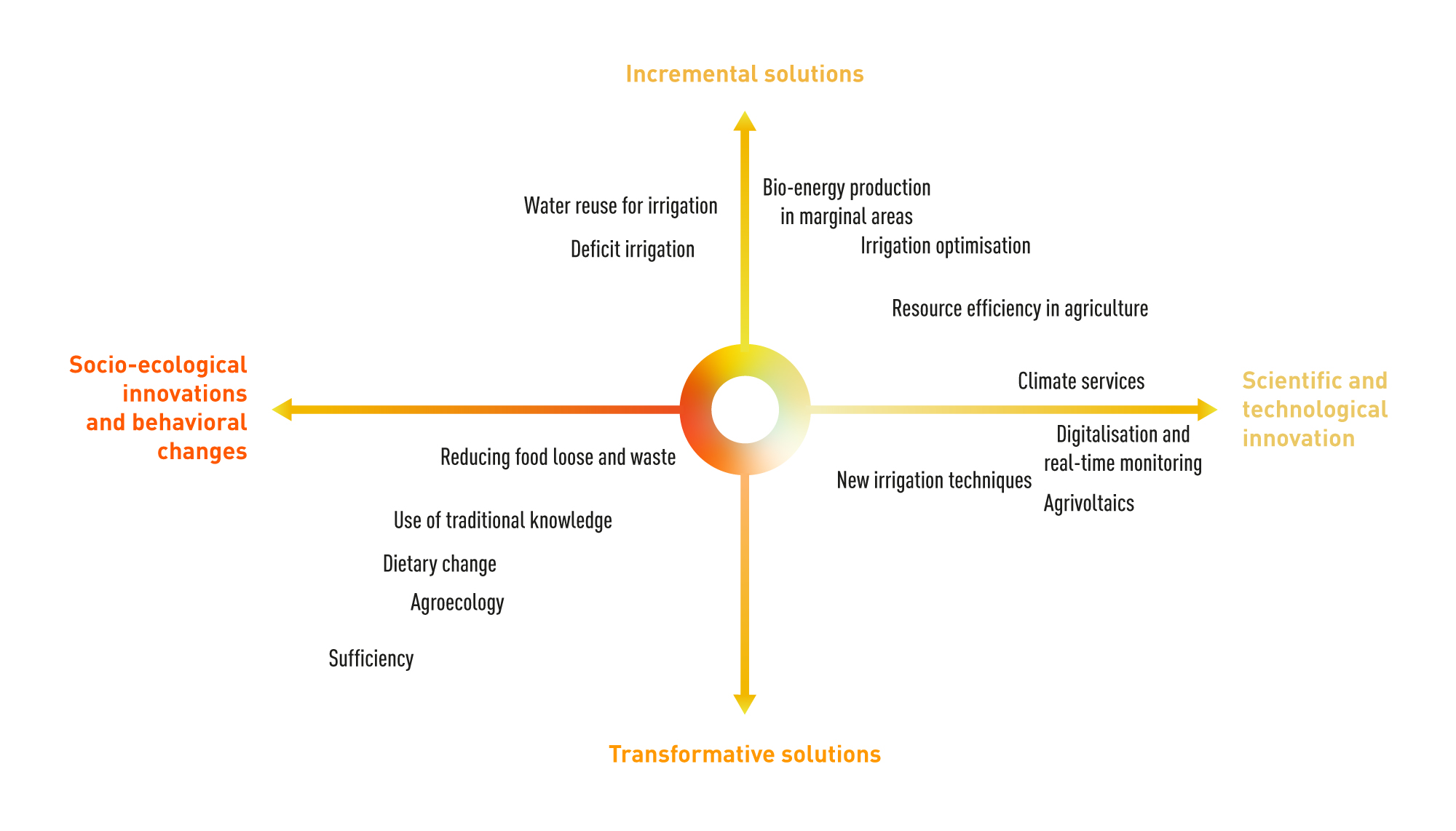
Figure SPM3 | Different gradients of possible adaptation and mitigation solutions for WEFE components used in the Mediterranean region. Adaptation and mitigation solutions range from incremental to transformative, and from scientific and technological innovation to socio-ecological innovations and behavioural change.
Figure SPM4 | Assessment of the main impacts and trade-offs of the WEFE nexus adaptation and mitigation solutions implemented in the Mediterranean countries.
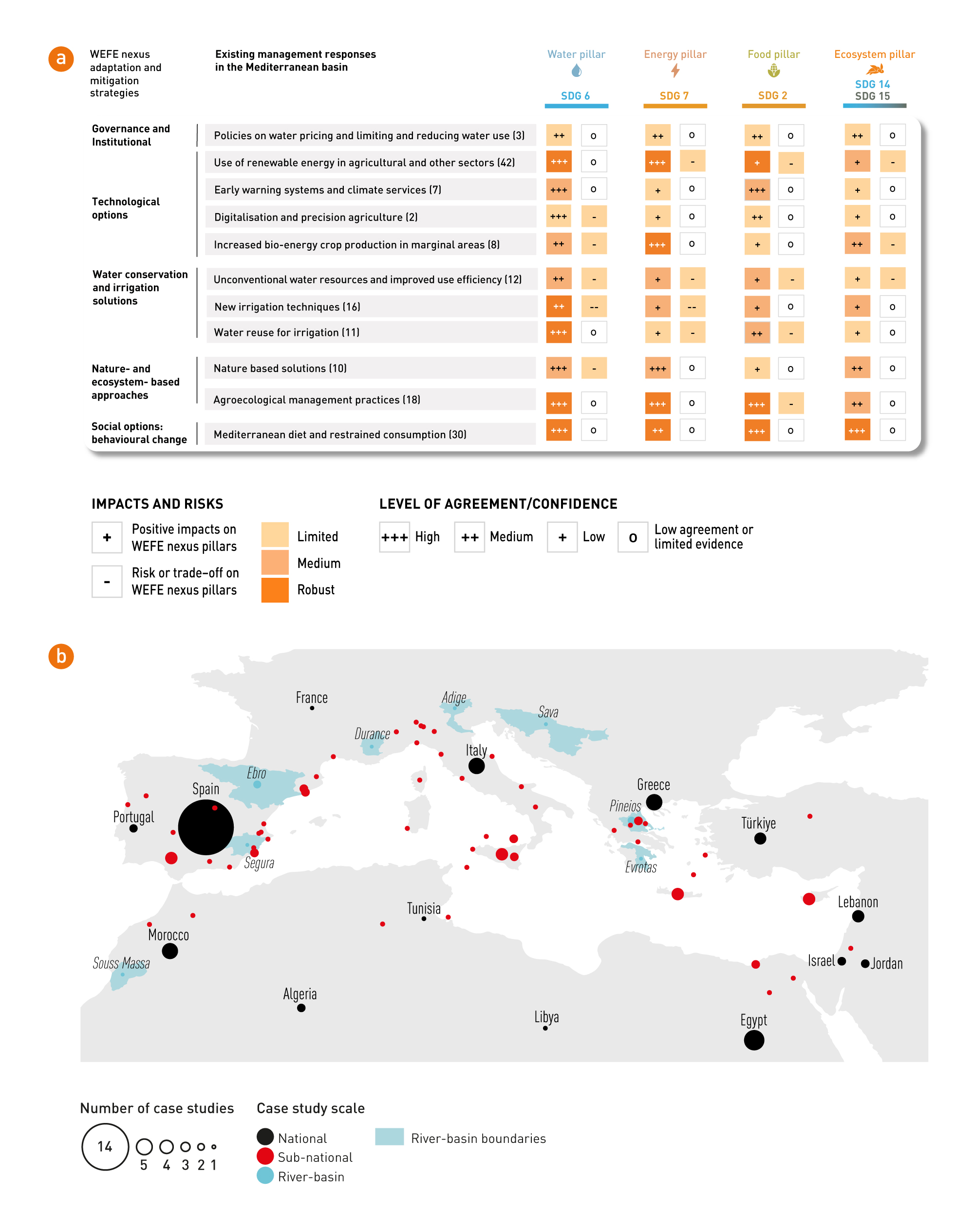
Figure SPM4 | (a) Assessment of the main impacts and trade-offs of the WEFE nexus adaptation and mitigation solutions implemented in the Mediterranean countries. The link is made to the SDGs through the nexus pillars. The numbers in brackets are the number of articles used for assessing each solution. The amount of evidence is quantified by the number of reviewed articles (given by numbers in brackets and categorised as limited in pale orange, medium in orange and robust in dark orange), while the degree of agreement measures the consensus between the articles (o for low agreement or limited evidence, + for low level of agreement/evidence, ++ for medium and +++ for high). This table does not review all possible solutions, but those implemented in the Mediterranean, reported in the scientific literature, and assessed in the report. (b) Spatial distribution of examined case studies.
C. From the nexus concept to its implementation for sustainable development
C.1. Data, indicators and assessments
C.1.1. Existing approaches used to tackle sustainability challenges in the WEFE sectors of the Mediterranean region have adopted fragmented planning and management frameworks that lack sufficient consideration of the intricate interconnections between these resource systems to address sustainability challenges in the Mediterranean (high confidence) {4.2}. The WEFE nexus approach offers an integrated planning, cross-sectoral cooperation, and decision-making framework to analyse the interactions between the WEFE components in the Mediterranean region and identify trade-offs and co-benefits that might be overlooked in single-sector approaches (high confidence) {4.2}. The WEFE nexus approach better identifies potential synergies or conflicts between sector policies because it provides a framework in which the role of ecosystem services is more explicit. The sustainable use of ecosystems and conservation of biodiversity are essential pillars for successfully achieving sectoral development goals in the Mediterranean region {4.2}.
C.1.2. The lack of complete and disaggregated data on the components of the WEFE nexus together with other issues related to data quality and accuracy, and the unwillingness of authorities to make certain types of required data available to researchers and other stakeholders are a major barrier to wider adoption and application of the WEFE nexus in the Mediterranean region {3.4; 4.2; 4.4}. The complexity and multi-disciplinary nature of the nexus means that the models and methods to assess it and provide results for the full spectrum of its benefits need to cover many different scientific fields. In addition, data are not typically collected or available on a long-term basis, meaning that for many cases, original data is necessary to showcase the benefits of WEFE approaches compared to other solutions {3.4.2}. Nevertheless, currently available data have been key to the creation of indicators for nexus indexes specific to the Mediterranean region. Monitoring tools and spatial indicators, generally related to multiple SDGs, have been developed to describe the national and local characteristics of food-water-energy-ecosystem interdependencies in the Mediterranean region, highlighting their high heterogeneity both within countries and between countries, and making it possible for Mediterranean countries to be ranked {4.3}.
C.2. Governance and stakeholder engagement
C.2.1. Governance for the WEFE nexus requires strengthened connections and better management through coordination, integration, coherence, deliberation and collaboration between actors and their respective strategies and actions, rather than the creation of new institutions {5.2}. To effectively utilise the WEFE nexus approach for sustainable development, key principles must be followed, including understanding the interconnections between resources within a system, developing new technologies for innovative solutions and roadmaps for their broad use throughout the region, facilitating social innovation and deliberative approaches, and ensuring coordination across sectors and stakeholders {4.2}. Deliberative processes that work well for: 1) values-driven dilemmas; 2) complex problems that require trade-offs; and 3) long-term issues that go beyond the short-term incentives of electoral cycles can contribute to WEFE nexus management {5.2.5}. WEFE governance is a polycentric system, with diverse and varying decision centres or actions within sectors, which requires identifying independent and overlapping key state and non-state actors – governments (acting through different ministries and public institutions), subnational (local and regional) authorities, civil society organisations, private sector, citizen groups, funders, multilateral and regional organisations (e.g. FAO, Plan Bleu, UfM, UNECE, etc.), national and international research institutions (AARINENA, CIHEAM, CMI, CNRS, , European Commission’s Joint Research Centre, GWP-Med, IRD, etc.), and national and International Development Agencies (e.g. ENABEL, GIZ, USAID, SIDA, etc.) (Figure SPM5) {5.2.1}.
C.2.2. Policies aimed at achieving sustainable development goals require systemic approaches and flexible forms of governance (i.e. the removal of institutional, technical, regulatory and economic barriers), in order to facilitate interdependencies across sustainability challenges and favour holistic approaches {4.2}. A pioneer of the WEFE concept at policy level is the IWRM framework designed to improve water resources management {4.2.; 5.1.1.}. Involvement of stakeholders from the quadruple helix (public administrations, academia, private sector and civil society) in the development and implementation of nexus approaches is crucial to providing multiple perspectives, ensuring political legitimacy and promoting dialogue on the sustainability of WEFE components {4.2}. Deliberative democracy instruments, such as citizen assemblies, can increase the legitimacy of political decisions and actions, enhance trust, and provide useful information on people’s preferences and what trade-offs they are ready to accept {5.2.5}. Involving intra-Mediterranean transnational collaboration is needed to face the climate emergency and promote equitable sharing of the risks and burdens associated with sustainable development {5.3.3}.
C.3. The concept-to-implementation gap
A concept-to-implementation gap has been identified in the Mediterranean context, meaning that the current situation is not satisfactory for the WEFE nexus with regard to nexus approach expectations.
C.3.1. Political and social conditions within Mediterranean countries involve varying levels of WEFE nexus policy implementation. The practical implementation of WEFE nexus policies has been limited and lacks coordination among the different levels of managing authorities, between sectoral departments, political actors, and stakeholders. EU countries have a common policy framework, which is not the case for MENA countries. Most policy initiatives on the WEFE nexus in Mediterranean countries have focused on assessments and analyses, reaffirming the importance of the concept. However, the implementation of such an approach is still lacking, and several measures are still designed in “silos” {5.1.1; 4.3} (Figure SPM5). Disjointed legal frameworks, marked by diverse and frequently conflicting laws, particularly in relation to transboundary resources, can be seen on both sides of the Mediterranean Basin. When deciding on policies to implement, it is therefore beneficial to thoughtfully consider potential cross-sectoral implications {5.1.1; 5.1.3}.
C.3.2. The limited effective implementation of WEFE nexus approaches in the region is attributed to an insufficient understanding of nexus trade-offs within science-policy-stakeholder interactions, to insufficient incentives {4.4}, limited vision, knowledge, development and investment, as well as the lack of solid empirical evidence regarding the potential benefits of a WEFE nexus approach {4.2}. Universities and research organisations serve as knowledge generators and brokers, and could integrate nexus thinking and organise policy dialogue into their research agendas and curricula {5.2.3}. Another key challenge is related to the costs of nexus approaches, which may be higher in the short term than those of silo approaches, due to the information, expertise, time, coordination and financial resources required {4.2}.
C.3.3. A series of actions and interventions are needed to build institutional capacities; enhance funding mechanisms; support intra-regional dialogue between implementers of the nexus approach, policymakers, and the general public; and pilot nexus approaches through modelling and assessment {5.3}. Public-private partnerships are considered effective for funding the WEFE nexus and improving capacity building and awareness of involved partners {5.3.3}. Approaches that integrate both environmental sustainability and considerations of local, regional and global governance, together with economic factors, are more likely to succeed in achieving real-world applicability {4.2}. WEFE nexus governance should promote transparency, participation, and accountability through dialogue and cooperation among Mediterranean countries, supplemented by collaboration with international organisations and deliberative processes involving citizens {5.1.1; 5.1.2; 5.1.5; 5.2.5} (Figure SPM5).
Figure SPM5 | Multi-level integrated and sectoral policies on the WEFE nexus in the Mediterranean.
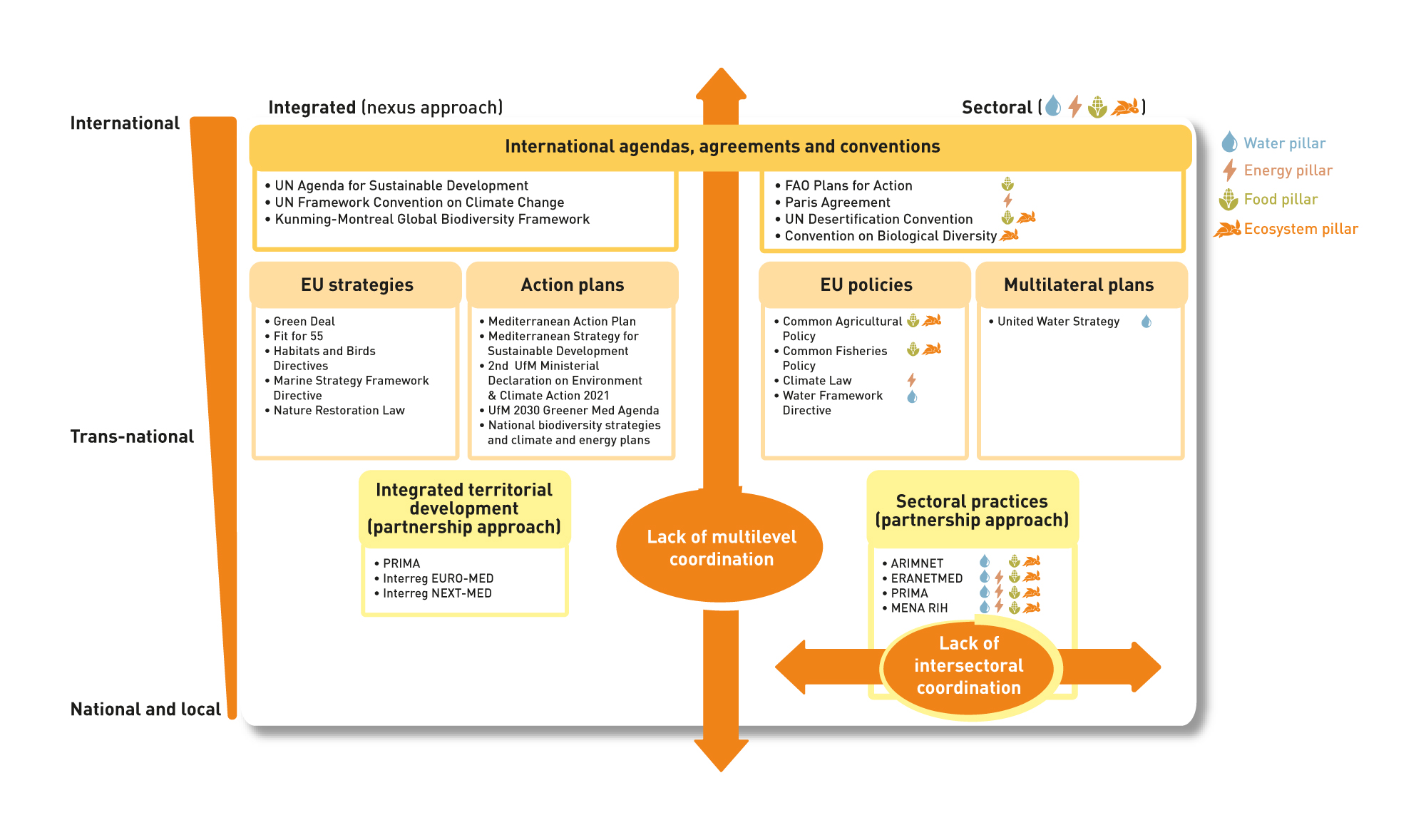
Figure SPM5 | Multi-level integrated and sectoral policies on the WEFE nexus in the Mediterranean (see {5.3.1; 5.3.3} for AIMNET, ERANETMED, MENA RIH and PRIMA programmes description).
How to cite the report
Contributors
Editors

Philippe
Drobinski
Laboratoire de Météorologie Dynamique / Institut Pierre Simon Laplace & Energy4Climate Interdisciplinary Center / France
hide

Marta Guadalupe
Rivera Ferre
INGENIO (CSIC-UPV) / Spain
hide

Mohamed
Abdel Monem
Senior Advisor for Climate Change and Rural Development / Egypt
hide

Fatima
Driouech
University Mohammed VI Polytechnic (UM6P) / Morocco
hide

Wolfgang
Cramer
IMBE, CNRS / France
hide
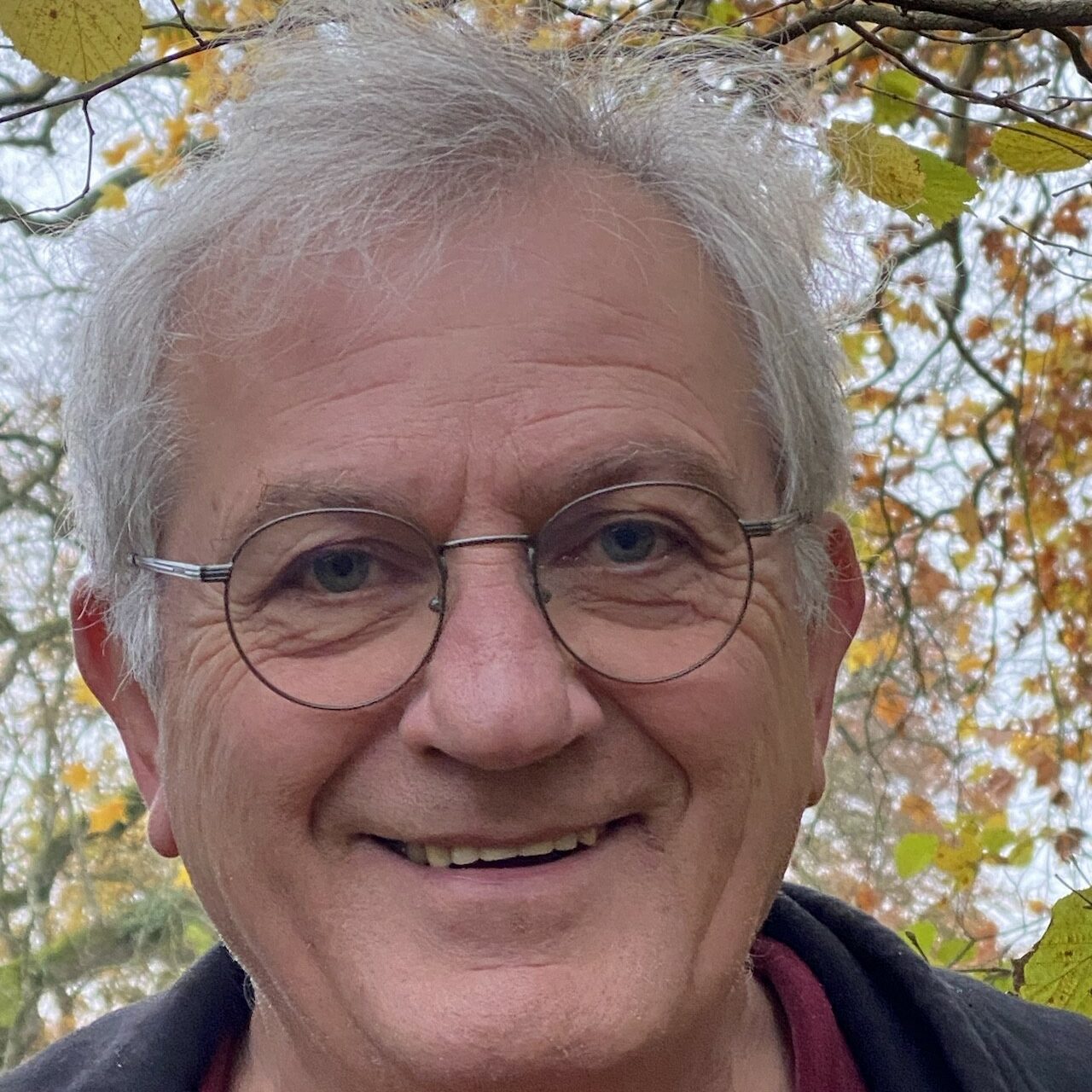
Joël
Guiot
CEREGE, CNRS / France
hide

Katarzyna
Marini
MedECC Secretariat / France
hide
Plan Bleu / France
hide

Julie
Gattacceca
MedECC Secretariat / France
hide
Association AIR Climat / France
hide
Report Coordinators
Coordinating Lead Authors

Assem
Abu Hatab
Nordic Africa Institute & Swedish University of Agricultural Sciences / Sweden
hide

Mohamed
Behnassi
Economic Social & Environmental Council (ESEC) | Rabat / Morocco
hide

Tarik
Chfadi
Mohammed VI Polytechnic University / Morocco
hide

Marta
Debolini
CMCC Foundation - Euro-Mediterranean Center on Climate Change / Italy
hide

Ahmed
El Kenawy
Instituto Pirenaico de Ecologia, CSIC, Spain / Spain
hide

Margarita
Garcia-Vila
Institute for Sustainable Agriculture, Centre of the Spanish National Research Council (CSIC) / Spain
hide
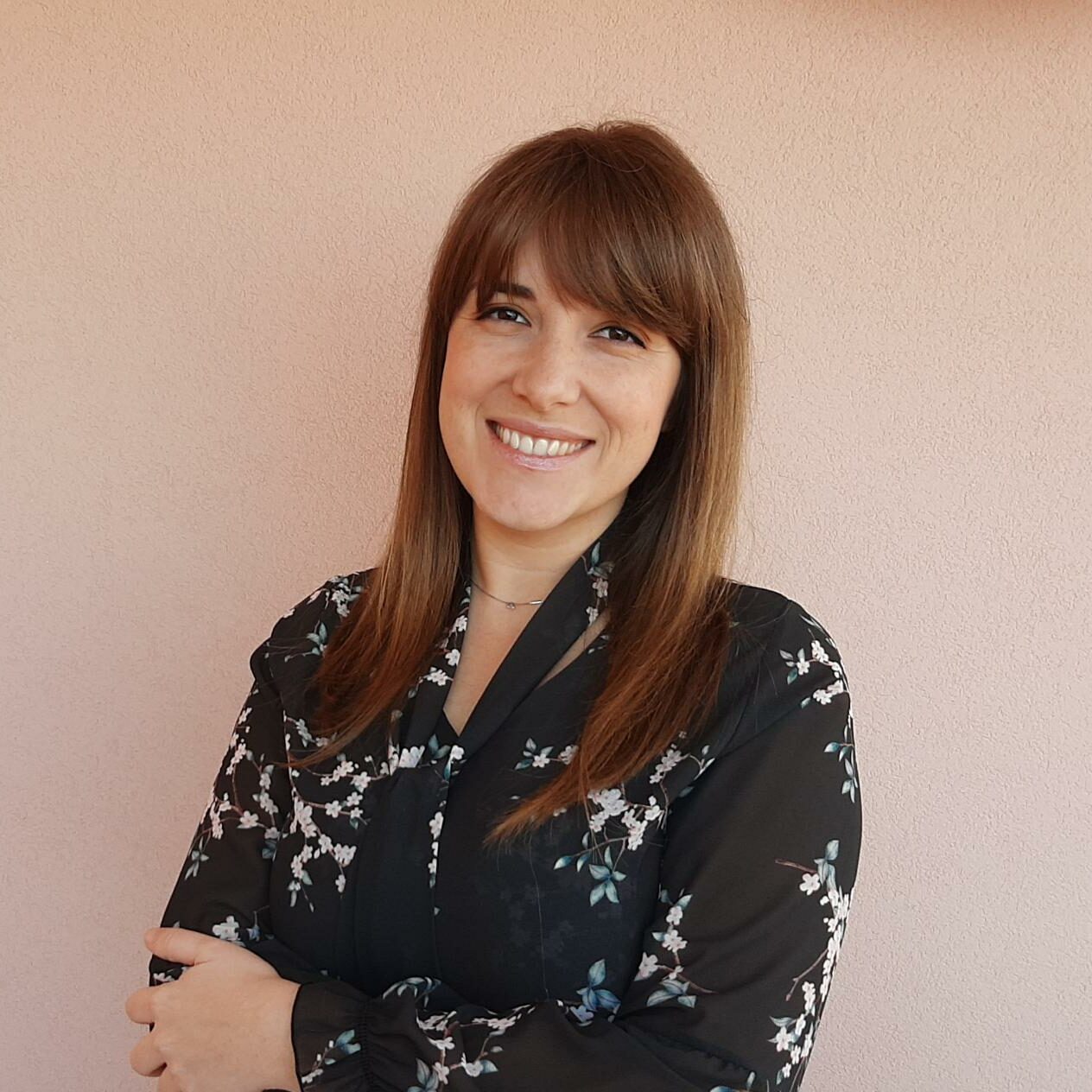
Emilia
Lamonaca
University of Foggia / Italy
hide

Feliu
López-i-Gelats
University of Vic-Central University of Catalonia (UVic-UCC) / Spain
hide

Žiga
Malek
Biotechnical Faculty, University of Ljubljana / Slovenia
hide

Maria P.
Papadopoulou
National Technical University of Athens / Greece
hide
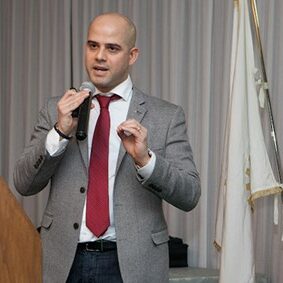
Fabio G.
Santeramo
University of Foggia / Italy
hide


